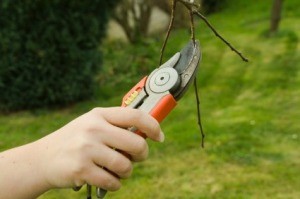 To prevent a limb from peeling down the side of a tree as it's removed, saw partway through the branch from the underside first. Make your upward cut close to the trunk and about one-third of the way through. Then start a second cut on top of the limb about one-half inch farther from the trunk than the first cut. When you have sawed down almost to the under cut the limb will break away cleanly.
To prevent a limb from peeling down the side of a tree as it's removed, saw partway through the branch from the underside first. Make your upward cut close to the trunk and about one-third of the way through. Then start a second cut on top of the limb about one-half inch farther from the trunk than the first cut. When you have sawed down almost to the under cut the limb will break away cleanly.
By Monica from Cortez, CO
Here are the questions asked by community members. Read on to see the answers provided by the ThriftyFun community.
Tips and instructions for pruning trees. Post your ideas.

Tree Pruning Tips
By Michael J. McGroarty
There are two kinds of winter gardening. The first method usually starts in January as the gardening catalogs begin to arrive in the mail. This type of gardening is as easy and sitting in your favorite chair, browsing the catalogs, and either dreaming about what you're going to do this spring, or actually drawing designs for the gardens you intend to work on.
The second type of winter gardening is to actually get out in the yard and do a little work. Of course if it's bitter cold, you'd be better off waiting for a good day. Winter is a good time to do some pruning if the temperatures are around 30 degrees or so. I don't recommend pruning if it's considerably below freezing because the wood is brittle and will shatter when you make a cut.
One of the advantages of pruning during the winter is that you can see much better what needs to be cut out and what should stay. At least that's true with deciduous plants. The other advantage is that the plants are dormant, and won't mind you doing a little work on them.
Ornamental trees should pruned to remove competing branches. Weeping Cherries, Flowering Dogwoods, Flowering Crabapples etc. have a tendency to send branches in many different directions. It is your job to decide how you want the plant to look, and then start pruning to achieve that look.
But first stick your head inside the tree and see what you can eliminate from there. This is like looking under the hood, and when you do you'll see a lot of small branches that have been starved of sunlight, that certainly don't add anything to the plant, they are just there, and should be cut out. Any branch that is growing toward the center of the tree where it will get little sunlight should be cut out. Where there are two branches that are crossing, one of them should be eliminated. Once you get the inside of the plant cleaned up, you can start shaping the outside.
Shaping the outside is actually quite easy. Just picture how you want the plant to look, and picture imaginary lines of the finished outline of the plant. Cut off anything that is outside of these imaginary lines. It is also important to cut the tips of branches that have not yet reached these imaginary lines in order to force the plant to fill out.
For the most part plants have two kinds of growth. Terminal branches and lateral branches. Each branch has one terminal bud at the very end, and many lateral branches along the sides. The terminal buds grow in an outward direction away from the plant. Left uncut they just keep growing in the same direction, and the plant grows tall and very thin. That's why the trees in the woods are so thin and not very attractive.
When you cut a branch on a plant, the plant sets new buds just below where you cut. When you remove the terminal bud the plant will set multiple buds, this is how you make a plant nice and full. Don't be afraid to trim your plants, they will be much nicer because of it. The more you trim them, the fuller they become.
Lots of people have a real problem with this. They just can't bring themselves to prune. Especially when it comes to plants like Japanese Red Maples. It kills them to even think about pruning a plant like this. Just do it! You'll have a beautiful plant because of it.
Look at the plant objectively. If you see a branch that looks like it's growing to far in the wrong direction, cut it. If you make a mistake it will grow back. Not pruning is the only mistake you can make. I hope this helps and doesn't get you in trouble with your significant other. Many a family feud has started over pruning.
About The Author:
Michael J. McGroarty is the author of this article. Visit his most
interesting website, http://www.freeplants.com and sign up for his
excellent gardening newsletter, and grab a FREE copy of his
E-book, "Easy Plant Propagation"

Stop pruning trees after they have leafed out. However, you should remove dead, damaged or diseased limbs throughout the year.
By Terri H.

Never trim trees without having your safety lines and a ground man on the ground helping you.
By Anthony Russell
Editor's Note: This is a good safety tip for anytime you are using a ladder to clean the gutters or getting on the roof. If the ladder falls, make sure there is someone on the ground to help.
Proper pruning is one of the best cultural practices a home owner or arborist can do for landscape trees. The benefits of correct pruning include improved plant health and form and a safe environment.